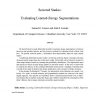Free Online Productivity Tools
i2Speak
i2Symbol
i2OCR
iTex2Img
iWeb2Print
iWeb2Shot
i2Type
iPdf2Split
iPdf2Merge
i2Bopomofo
i2Arabic
i2Style
i2Image
i2PDF
iLatex2Rtf
Sci2ools
ICCV
1998
IEEE
1998
IEEE
Sectored Snakes: Evaluating Learned-Energy Segmentations
We describe how to teach deformable models to maximize image segmentation correctness based on user-specified criteria, and we present a method for evaluating which criteria work best. We present sectored snakes, a formulation that demonstrably improves upon regular snakes. A traditional deformable model ("snake" in 2D) fails to find an object's boundary when the strongest nearby image edges are not the ones sought. But models can be trained to respond to other image features instead, by learning their probability distributions. The implementor must then decide on which of many image qualities to teach the model. To this end, we show how to evaluate the efficacy of any resulting deformable model, given a sampling of ground truth, a model of the range of shapes tried during optimization, and a measure of shape closeness. In the domain of abdominal CT images, we demonstrate such evaluation on a simple "sectoring" of a snake, in which intensity and perpendicular ...
Abdominal Ct Images | Computer Vision | Deformable Models | ICCV 1998 | Image Segmentation Correctness | Strongest Nearby Image | Traditional Deformable Model |
| Added | 15 Oct 2009 |
| Updated | 15 Oct 2009 |
| Type | Conference |
| Year | 1998 |
| Where | ICCV |
| Authors | Samuel D. Fenster, John R. Kender |
Comments (0)

